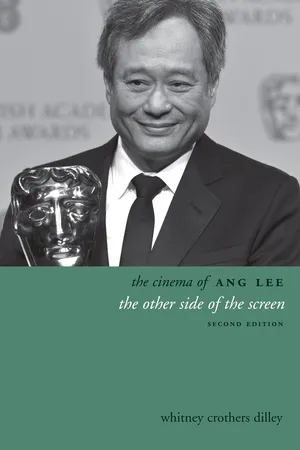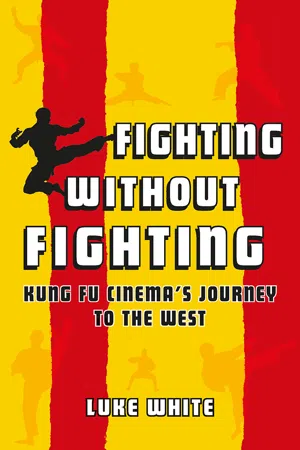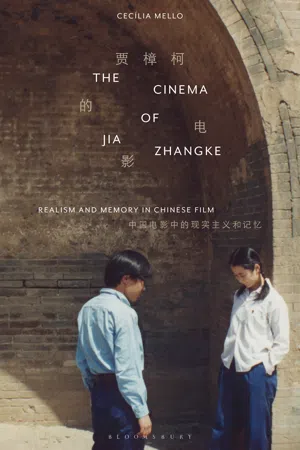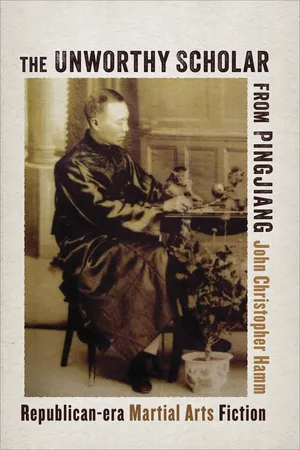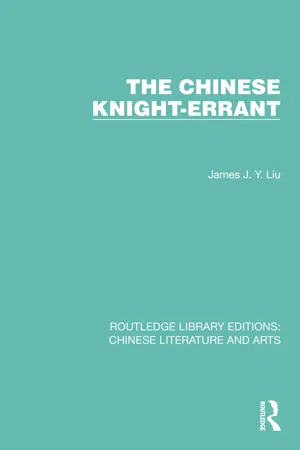Literature
Wuxia Literature
Wuxia literature is a genre of Chinese fiction that typically features martial arts, chivalrous heroes, and adventures set in ancient China. The term "wuxia" translates to "martial hero" and the stories often revolve around themes of honor, loyalty, and righteousness. Wuxia literature has had a significant influence on Chinese popular culture and has gained international recognition through films, television, and literature.
Written by Perlego with AI-assistance
Related key terms
Related key terms
1 of 4
Related key terms
1 of 3
9 Key excerpts on "Wuxia Literature"
- eBook - ePub
The Cinema of Ang Lee
The Other Side of the Screen
- Whitney Crothers Dilley(Author)
- 2014(Publication Date)
- WallFlower Press(Publisher)
wuxia world, a reader must take these impossible feats as a matter of course.For the Western viewer experiencing wuxia for the first time, the fact that these clan members can run up walls and take off into flight (as the masked robber of the Green Destiny sword does in an early scene), ignoring normal laws of gravity, or can stand on bamboo stalks and sway around dangerously, lightly jumping from one bamboo stalk to another (as Mu Bai and Jen do), without any branches breaking, is initially startling. For Chinese viewers familiar with the wuxia genre, these tropes are well known; Chinese readers have pored over these novels and imagined the scenes of flying warriors in their heads for years—however, the advent of Lee’s film Crouching Tiger, Hidden Dragon marked the first time a director actually risked attempting to portray these fanciful visual images onscreen. The aforementioned “bamboo grove” fight sequence is one example of a common trope for the genre—King Hu’s masterpiece wuxia film, A Touch of Zen (Xianü, 1969), also had a bamboo grove fight scene, but his warriors had to stay at ground level because of the limitations of special effects at that time. In Lee’s world, wuxia warriors magically float at the tips of the trees, and for the uninitiated Western viewer, images like this were entirely new and unexpected, leading to a sense of childlike wonder and exhilaration. Western audience members may have spent a few seconds wondering about these strange occurrences, but ultimately decided that they just did not mind, even if it did not make “sense.” The flight choreographer for these otherworldly scenes was Yuen Wo Ping, who had already come to the attention of mainstream cinemagoers for his work in The Matrix (1999), another visually startling film. (One can only imagine how much more powerful these images would have been had one not already seen the astonishing special effects of the twirling slow-motion flight choreography of The Matrix - eBook - ePub
Translation and Fantasy Literature in Taiwan
Translators as Cultural Brokers and Social Networkers
- Y. Chung(Author)
- 2013(Publication Date)
- Palgrave Macmillan(Publisher)
Wu Xia novels can be regarded as one of the emblems and inheritance of Chinese fantasy literature in modern society.Wu Xia as a literary genre corresponds with its heroic figures and imaginary world to some extent similar to ‘high fantasy’19 in the West. Both depict a world battling between right and wrong and exalt heroic conduct. The value reflected behind these two forms may be different but a similarity can be retrieved from their narrative structure. The connection can be drawn between the prevalence of heroic fantasy such as The Lord of the Rings and Wu Xia novels in Taiwan. To date, the popularity of Chinese fantasy films with Wu Xia elements can help the Western world catch glimpses of the different forms and styles and possible developments of fantasy in the history of Chinese culture. Chinese fantasy in the form of Wu Xia is primarily a form of martial exercises emphasizing self-defence rather than attack. It reflects a distinct living mental state and philosophy which the Chinese people value highly.20 Most of the Chinese Wu Xia works describe the battle between right and wrong, but some of them go beyond this level towards individual self-fulfilment. In this case, martial arts are the essential tools for the protagonists to master themselves and to become heroes. They first strive to excel in martial arts in order to defeat or take revenge on their rivals; then they seclude themselves from people and choose to be hermits. This is a very common plot in Chinese Wu Xia novels. Their unique style and narrative to some degree reflect both the utilitarian and idealistic characteristics of Chinese people, which differ from the mission-minded type of Western heroism, yet still refer to fantasy. In general, the quest of the ‘hero’ or the protagonist from both the East and the West is similar, full of trials and obstacles, yet their goals are rather different. For the heroes in the West, it is the pursuit of mission (Auden 1976: 42);21 - eBook - ePub
Fighting without Fighting
Kung Fu Cinema's Journey to the West
- Luke White(Author)
- 2022(Publication Date)
- Reaktion Books(Publisher)
Many of China’s great ‘classical’ epics emerged from much older cycles of stories and dramas that placed martial artists and martial artistry at their heart: for example, the sixteenth-century Journey to the West (also known as Monkey); the fourteenth-century Outlaws of the Marsh (also known as The Water Margin); and Romance of the Three Kingdoms, from which Mount Dingjun draws its plot. Aside from the written word and the stage, popular stories were promulgated to the illiterate by professional storytellers in markets and teahouses, helped by prompt books. As the nineteenth century progressed, something more like modern martial arts novels appeared. By the early twentieth century, wuxia had emerged as a highly popular literary genre, integrated into the circuits of the new mass-media technologies. Tales of wandering swordsmen were serialized in newspapers and also adapted for radio. The novel that above all lit the fuse for the wuxia craze was Xiang Kairan’s Marvellous Gallants of the Rivers and Lakes, which began serialization in 1923. 9 This was adapted in its turn to create the definitive martial arts movie of the 1920s, Burning of the Red Lotus Temple (1928). In this, the young swordsman Lu Xiaoqing, returning from his martial arts apprenticeship, stays the night at a Buddhist monastery, only to discover that an evil gang have substituted themselves for the real monks there and are using the temple as a headquarters for their operations kidnapping and trafficking women. Along with a group of other young heroes, and under the mentorship of the mysterious and powerful Red Maiden, he fights his way through the monastery’s hidden mechanical traps, defeats the bandit gang and puts the temple to the torch. Reputedly, some four hundred martial artists were recruited to provide the stunts - Riccardo Moratto, Defeng Li, Riccardo Moratto, Defeng Li(Authors)
- 2022(Publication Date)
- Routledge(Publisher)
11 Are Translated Chinese Wuxia Fiction and Western Heroic Literature Similar? A Stylometric Analysis Based on Stylistic Panoramas1Kan Wu and Dechao LiDOI: 10.4324/9781003298328-1211.1 Introduction
Wuxia, or Chinese martial arts fiction, is a traditional genre of Eastern heroic literature that originated from unique historical and cultural contexts during China’s Warring States Period (475–221 BC) (Huang 2018 , 152). Previous research on Wuxia (Flannery 2012 ; Vander Elst 2017 ; Keulemans 2020 ) has attempted to compare this type of Chinese heroic literature with Western chivalric stories and heroic fantasies – two subgenres of heroic literature deriving from a medieval background (Honegger 2010 , 61). Those studies have demonstrated that Wuxia could be very different from the two Western subgenres in terms of cultural values, religious belief, and above all, worldviews, even though they share the heroic theme. Wu and Li, however, discovered that when readers read a Wuxia translation, they sometimes experience a déjà vu–like reminder of chivalric stories or heroic fantasies (Wu and Li 2018 , 102–3). This raises the question as to whether there are any possible stylistic connections between heroic literature in the East and that in the West. An examination of such stylistic connections may give us clues about the current reception of translated Wuxia and is hence our first research objective. To conduct the investigation, we turn to Stylometry – the statistical analysis of literary styles (Holmes 1998 , 111) – for methodological support.Existing stylometric research on (translated) texts of varied genres has employed a number of stylistic indices at such linguistic levels as characters (Daelemans 2013 ; Eder et al. 2016 ), words/lexes (Jones and Nulty 2019 ; Melka and Místecký 2020 ), n-grams/clusters (Mastropierro 2018 ; Valencia et al. 2019 ), sentences and paragraphs (Rong et al. 2006 ), tones and rimes (Hou and Huang 2020 ), and their combinations (Brocardo et al. 2014 ; Liu and Xiao 2020- eBook - ePub
The Cinema of Jia Zhangke
Realism and Memory in Chinese Film
- Cecília Mello(Author)
- 2019(Publication Date)
- Bloomsbury Academic(Publisher)
At the same time, it set the trend for filming opera scenes as a guarantor of success for the cinema in China, where a vast array of classical stories that came from oral tradition, moved to literature and then to opera, could now nourish cinema, thus turning this foreign art into a more popular and familiar medium (Berry and Farquhar 2006). This amalgam allowed at the same time for the dissemination of operatic pieces beyond their regional origins and their linguistic barriers. Cinema thus emerged as a lingua franca, and from then on the relationship with the opera has never been abandoned, taking on different forms and functions throughout history. Berry and Farquhar (2006) called this the ‘operatic modes’ of Chinese cinemas, which can emerge from specific local cultures and are hybrid and impure. One of these forms is the so-called wuxia cinema that flourished as a genre especially in the 1960s and 1970s in Hong Kong and Taiwan. The wuxia – meaning ‘martial arts’ or ‘swordsman’, designates a fictional genre in China, originating in literature and having since spread to other media such as the opera, the cinema and television, the world of comic books, animation and video games. The highly stylized and rhythmic choreographies of action sequences in the wuxia cinema, as well as its anecdotal repertoire, are heirs to the opera. Not by chance, director King Hu, the master of Hong Kong and Taiwan wuxia cinema, often employed a martial arts choreographer, Han Yingjie, trained in and a star of traditional Peking Opera, capable of designing a highly sophisticated interchange of stasis and movement in the Kung Fu fighting sequences - Stephen Teo(Author)
- 2021(Publication Date)
- Routledge(Publisher)
This book is aimed at forging an inroad into the literature on these very topics, and for this effort, it crosses disciplinary boundaries between film studies and philosophical studies. In my previous book on the martial arts film, Chinese Martial Arts Film: The Wuxia Tradition, I focused essentially on the history of the genre and on its development in the Hong Kong cinema, chiefly, and in the mainland Chinese film industry from the start of the new millennium onwards (the genre really only took off in China from 2002 onwards, since it was banned in the mainland from the 1930s until the late 1970s). My new book will complement my previous book by giving a new focus on the philosophy of Chinese martial arts film through a sustained focus on a selected core of films that I deem to be representative for the analytical effort at hand. The genre imparts a general if perhaps superficial knowledge of martial arts and the precepts underlining action and the thinking behind the actions of the protagonists. Apart from its faculties of entertaining audiences around the world, the genre, I believe, is a functioning channel for people, whether Easterners or Westerners, to obtain some cognizance of Chinese thought and history. The focus will indeed be on Chinese philosophy which has a long history, and the reason for this focus is both subjective and objective—subjective inasmuch as Chinese philosophy is of personal interest to me, and objective because no wuxia film could be bereft of Chinese philosophical concepts: they are naturally present in the films albeit lying hidden, being deeply embedded in the structures. My interest in Chinese philosophy takes the form of a search for intellectual roots which coincide with my own fondness for wuxia film and the literature- eBook - ePub
The Unworthy Scholar from Pingjiang
Republican-Era Martial Arts Fiction
- John Christopher Hamm(Author)
- 2019(Publication Date)
- Columbia University Press(Publisher)
These elements, their ramifications, and their interactions—including both their synergy and the tensions among them—are essential to the poetics of xiaoshuo as a genre in the Republican era. Embedded in this poetics are an uncertainty about the value of xiaoshuo and presumptions about its limitations that echo critiques by contemporary progressive critics yet derive from premodern discourse on the genre. Xiang Kairan’s contemporary and colleague Bao Tianxiao relates that the Republican vogue for martial arts fiction began, and the modern genre of martial arts fiction was created, through the marriage of Xiang Kairan’s unique literary talents with the entrepreneurial vision of the publisher Shen Zhifang 沈知方 —a marriage for which Bao played matchmaker. Modern scholarship has by and large accepted Bao’s account. Chapter 3 undertakes to unpack this version of the genre’s origins, examining in more detail the question of in just what sense Xiang and Shen’s collaboration may be said to mark the creation of wuxia xiaoshuo as a thematic genre. It begins by reviewing the history of notions of fictional subtypes in China and the late-Qing interest in the question of genre, then proceeds to examine the status before the 1920s of two particular thematic genres: detective fiction and fiction of martial arts and chivalry. Key to my investigation is the fact that Modern Times, one of the founding works of modern martial arts fiction, was featured in Shen Zhifang’s magazine Detective World (Zhentan shijie 偵探世界). I argue that while this placement may seem at first glance no more than an editorial convenience, it was in fact a concrete factor in the process by which wuxia xiaoshuo achieved its modern identity and exemplifies the logic by which the process took place - eBook - ePub
Chinese History and Literature
New Ways to Examine China's Past
- Ruiquan Gao, Guanjun Wu(Authors)
- 2018(Publication Date)
- WSPC(Publisher)
Chapter 10 The Status and Uniqueness of Modern Chinese Xiaoshuo * Chen Dakang The history of Chinese Xiaoshuo fiction) can be actually described as an evolutionary growth along with societal development, hence the growth trajectory more and more convoluted in this course. Since the establishment of fiction as a literary genre in the Wei-Jin and the Northern and Southern dynasties, the development of Chinese fiction had undergone several phases of transformation. Firstly, it is the creation of chuanqi a collection or body of legends) in the Tang Dynasty, which was “created intentionally to be a type of fictions for the very first time”. 1 Secondly, the rise of huaben (story-telling scripts) in the Song and Yuan Dynasties, which reflects the rapidly-growing demands for entertainment of the citizens at that time and the acceptance and fondness of such literary genre of fiction by the great mass. Thirdly, it is the publication of the Sanguo Yanyi (the Romance of the Three Kingdoms) and Shuihu Zhuan (Out of the Water Margin) in late Yuan and early Ming dynasties, when popular fiction was created for daily reading by the public, although this type of reading behaviors was only commonplace until the Mid-Ming Dynasty. Fourthly, it is the reform of fiction in Ming and Qing dynasties, when popular fiction was finally established as an independent genre created by literati after existing for a long period in forms like adaptations of huaben drama and folklores. At this time, the ancient Chinese fiction was approaching its end point in feudal times, but it was still to undergo the phase of modern development before entering the contemporary era - eBook - ePub
- James J.Y. Liu(Author)
- 2022(Publication Date)
- Routledge(Publisher)
Sun Nan, with nothing to do, thought to himself, ‘Why not kill some more snakes?’ So he let out his sword-ray and pointed it at random at the snakes below. Seeing this, Ling-yun also let out her flying sword. The two sword-rays moved up and down like two dragons among the yellow clouds. After an hour or so, they saw Ling-yun’s mother coming with Chin-ch’an, the latter holding at the point of his sword the human-shaped head of the monster, as big as a huge water jar. (Later, Chu Mei, who had been hit by a poisonous arrow, was saved with the help of a pearl obtained from inside the monstrous serpent’s head.)All this is no doubt childish nonsense, but one has to admit the author has shown some ingenuity and imagination.4. Tales emphasizing physical feats
Another type of fiction that is still very popular consists of tales whose main interest lies in descriptions of amazing feats of strength and of various schools of swordsmanship and boxing. Some of these tales are based on the lives of actual persons, but the accounts of their feats are no doubt greatly exaggerated. This kind of fiction is usually dubbed ‘military-chivalric’ (wu-hsia), though it is often more concerned with physical culture and methods of fencing and boxing than with chivalry.The various schools of swordsmanship and boxing described in these tales fall into two main categories: those who cultivate ‘inner’ or ‘soft’ strength, and those who cultivate ‘outer’ or ‘hard’ strength. The former make use of breath control and anatomical knowledge to defeat opponents seemingly stronger, while the latter concentrate on muscular strength and are supposed to be able to lift great weights and break stones, etc. It is believed that one school of Chinese boxing was introduced to Japan in the seventeenth century and became the origin of judo. Karate (empty-handed combat) may also have been influenced by Chinese boxing.1In these tales, no less than in real life, Chinese physical culture is shrouded in mystery, and descriptions of fencing or pugilistic methods are often couched in pseudo-metaphysical language. For example, the most famous style of boxing and one that is still practised today (even by some Westerners) as a form of exercise, the t’ai-chi-ch’üan,2 is named after the mystic symbol t’ai-chi
Index pages curate the most relevant extracts from our library of academic textbooks. They’ve been created using an in-house natural language model (NLM), each adding context and meaning to key research topics.
Explore more topic indexes
Explore more topic indexes
1 of 6
Explore more topic indexes
1 of 4
